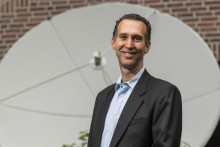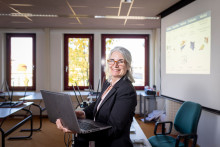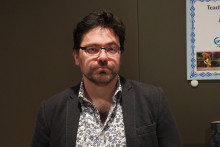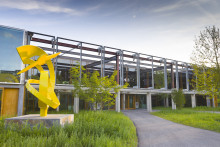‘In general, the focus of my work is to use remote sensing to find geo-resources. Those include precious minerals, critical raw materials such as lithium for batteries, rare earth elements for magnets and so on. Essentially, we want to see what we can find in the earth that can help us to develop as humanity and to support the energy transition,’ explains the scientist.
Hecker’s specialization is so called thermal infrared imaging, which allows him to detect not only particular minerals but also temperature differences – something that will come in handy in the aforementioned project for NASA.
Science and Application Team
How does a UT researcher end up on NASA Science and Application Team? ‘I worked at NASA during my sabbatical in 2006,’ answers Hecker. ‘That was really exciting, by the way. We worked in the building right next to the Mars rover group and we would often have lunch with them and discuss where they were sending the rover next. I made a lot of contacts there during the time. Thanks to that I heard about the call for the Science and Application Team and I applied. It is highly competitive and prestigious. It’s great to be at the table and discuss the latest developments, to give your input.’
‘At the table’, Hecker is the principal investigator for project GeoHot (Geothermal hotspot detection from Space Station-based ECOSTRESS data). ‘To explain: there is a sensor on the International Space Station (ISS) called ECOSTRESS. It was developed to measure evapotranspiration in plants, and therefore monitor vegetation stress. But then we, geologists, came and said: this sensor could also be used for something totally different,’ says Hecker. ‘It could help us search for geothermal areas, which we could use for sustainable electricity production and heating.’
International Space Station
Scientists have already been trying to pinpoint such geothermal areas using other remote sensing methods, but there are limitations, explains the researcher. ‘We can use data from orbiting satellites, but those only give us images from the same moment of every day. That is not reliable, because it doesn’t show the heat changes throughout the day. We can also use geostationary satellites, which are placed over the equator and revolve in the same direction the earth rotates. But those are so far away they only offer very coarse imagery.’
'The space station offers a completely different platform'
‘The space station offers a completely different platform,’ continues Hecker. ‘It has its own orbit and can obtain much finer images. It simply allows you to observe things that other satellites don’t. Yes, you can use it to monitor plants, but you can also use it to monitor temperature of rocks. That way we can find areas with higher heat flux from the earth: the geothermal fields.’

Algorithm for everyone
Hecker’s goal within the NASA GeoHot project is to use data from the ECOSTRESS sensor and develop an algorithm for detection of thermal anomalies. ‘We hope to start with that in January,’ he says. ‘It is a three year project, but our long-term goal is to have an algorithm accessible to the public – as is normal with NASA and NWO projects -, so that anyone can use it to find geothermal areas and renewable energy sources at any location on the planet.’
funded by nwo
Although the research project falls under NASA, as a non-American scientist, Chris Hecker and his ITC team cannot be financed by the U.S. governmental agency. To conduct the research, Hecker has therefore received funding from the Dutch Research Council (NWO).







